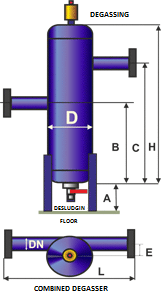Combined degasser
Application
Combined degasser extracts free gas particles from a liquid (mainly air and carbon dioxide CO2) and sludge in a form of small crystals that is present in the liquid as a result of non-chemical water treatment. It also removes other solid particles from the liquid. Degassing of the liquid results in higher efficiency of physical water treatment, increases reliability of thermostatic valves and prevents corrosion. Combined degasser separates gas from liquid with 95% efficiency, impurities with 70-90% efficiency, depending on the particle density. If necessary, it is possible to connect the degasser in series or in parallel. Default position of the degasser is vertical, does not require electrical power, there is no need for maintenance and has got no operating costs. It is designed to work under operation pressure of 0.6 or 1.6 MPa and 110°C. Optimal flow rate is 0.5 to 1.5 m3/s and within this flow rate there is 5-15 kPa pressure loss.
How it works
Combined degasser KO separates solid and gas particles from the liquid, provided that tangential entry and higher entry speed are ensured. Separation of particles takes place in a cylindrical vessel as a result of centrifugal force and different densities of particles/ impurities and the flowing liquid. Impurities then fall from the cylindrical vessel to the bottom part of the device where they are regularly discharged. A degassing valve is placed in the upper part of the device which is automatically releasing gas from the liquid. Standard parts of the vessel are a ball tap and companion flange to drain the sludge. Automatic draining of the sludge is not a standard part of the device but can be supplied extra. When rotating upward, clean liquid then excludes free gas particles which are gathered underneath the lid of the degasser from where they are automatically released into the air.
Servicing and maintenance of the device
Combined degasser needs to be serviced by regular removal of sludge and regular inspection of degassing valve. It is also necessary to check watertight integrity of devices’ joints.
Dimensions
| TYPE | DN | D | A | B | C | H | L | Q |
|---|---|---|---|---|---|---|---|---|
| KO 15 | G 1/2 " | 125 | - | 200 | 350 | 530 | 300 | 1 |
| KO 20 | G 3/4 " | 150 | - | 260 | 420 | 640 | 400 | 1,8 |
| KO 25 | G 1 " | 200 | - | 320 | 500 | 740 | 450 | 2,7 |
| KO 32 | G 5/4 | 200 | - | 400 | 600 | 860 | 450 | 4,4 |
| KO 40 | G 6/4 " | 250 | 400 | 500 | 720 | 1000 | 500 | 6,8 |
| KO 40 | 40 | 250 | 400 | 500 | 720 | 1000 | 550 | 6,8 |
| KO 50 | 50 | 300 | 400 | 600 | 840 | 1160 | 600 | 11 |
| KO 65 | 65 | 350 | 400 | 700 | 960 | 1340 | 650 | 18 |
| KO 80 | 80 | 400 | 400 | 900 | 1200 | 1670 | 700 | 27 |
| KO 100 | 100 | 500 | 450 | 950 | 1300 | 1800 | 800 | 40 |
| KO 125 | 125 | 600 | 450 | 1150 | 1550 | 2070 | 900 | 60 |
| KO 150 | 150 | 700 | 450 | 1400 | 1850 | 2430 | 1000 | 90 |
| KO 200 | 200 | 800 | 500 | 1700 | 2300 | 2940 | 1100 | 160 |
| KO 250 | 250 | 900 | 500 | 2000 | 2600 | 3320 | 1200 | 250 |
| KO 300 | 300 | 1000 | 500 | 2200 | 2900 | 3700 | 1300 | 360 |

Q/ maximal flow rate in m3/ hour
KO, types DN40 and up are supplied with solid base
It is necessary to state type of the device (diameter of the pipe), temperature and pressure in the order.

 +420 608 776 299
+420 608 776 299 


